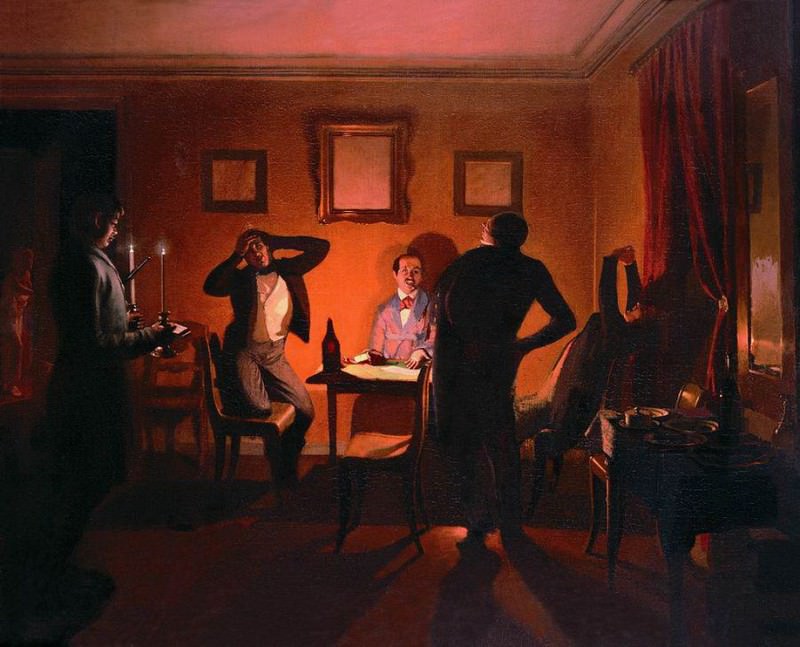Players Pavel Fedotov (1815-1852)
Pavel Fedotov – Players
Edit attribution
Download full size: 918×742 px (0,1 Mb)
Painter: Pavel Fedotov
Pavel Fedotov’s painting is very peculiar. In The Gamblers, for example, the author tries to portray what is going on through the eyes of a hero who has lost, and for him his partners have become horrible phantoms. The players spent the entire evening in mutual deception, competing, winning, and losing. All behaved passionately and calculatingly, but they were together. They were united by a table of green cloth and the light of a burning candle.
Description of Pavel Fedotov’s painting The Gamblers
Pavel Fedotov’s painting is very peculiar. In The Gamblers, for example, the author tries to portray what is going on through the eyes of a hero who has lost, and for him his partners have become horrible phantoms.
The players spent the entire evening in mutual deception, competing, winning, and losing. All behaved passionately and calculatingly, but they were together. They were united by a table of green cloth and the light of a burning candle. And all the while the hope of change for the better smoldered. The night passed, and those who won found themselves on one side of the Rubicon of light, and those who lost - on the other. In the painting, they are separated not only by light, but also by the space of the room and the movements.
The loser is illuminated by two candles that stand on the table, so the figure appears as a kind of double halo of dark color. The winning figure is depicted by the artist with unlit shadows.
He doesn’t move, and they somehow wriggle. He has lost, but he does not panic or cry, but clutches the glass of wine in one hand and helplessly twists the other with his palm upward. Despite his loss, he seems ridiculous: he has an unfinished cigar in his teeth, and some kind of cartoonish grimace on his face, which looks like a smile. The loser looks like a madman, he is in a trance, acting aloof and silent, like a lonely spectator who looks at the actors from the stalls, the player looks at his fellow players, but does not see them.
The winners dodge the bright lights. They scatter in all directions. They are simply faceless, monstrous phantoms, punished for winning in incomprehensible agony. All three seem to have been portrayed differently by the artist, but they are all terrifying, lifeless, unnatural.
And these three empty souls wriggle against a bare wall where three empty frames and three reflectors of evil - mirrors - hang.
This is how masterfully Fedotov in "The Players" showed how people who spent time at the card table turned into empty shells.
Кому понравилось
Пожалуйста, подождите
На эту операцию может потребоваться несколько секунд.
Информация появится в новом окне,
если открытие новых окон не запрещено в настройках вашего браузера.
You need to login
Для работы с коллекциями – пожалуйста, войдите в аккаунт (open in new window).




















COMMENTS: 1 Ответы
нужен анализ картины игроки
You cannot comment Why?
This painting, titled Players, depicts a scene of intense psychological drama unfolding in an dimly lit room. Four men are present, their postures and expressions conveying a range of emotions from anxiety to possibly triumph or despair.
On the left, a man stands holding a tray with candles and a small object, appearing to be an observer or perhaps involved in a ritualistic aspect of the scene. His face is obscured by shadow, adding to the mystery.
In the center, a man is seated, his head in his hands, a dramatic gesture of distress or deep thought. His body language suggests he is losing a game, experiencing the weight of defeat. Beside him, on a table, is a bottle of wine and some papers.
Across from him, another man leans over the table, his face illuminated by a lamp, looking intently at something on the table. He appears to be the winner or has just made a significant move. His expression is difficult to discern clearly but seems to hold a sense of anticipation or a satisfied smirk.
To the right, a fourth man stands silhouetted against a rich red curtain, his back to the viewer. He is looking upwards, his expression and intent unclear. His posture is somewhat relaxed, contrasting with the tension felt elsewhere in the room.
The subtexts in Players revolve around themes of gambling, fate, and human emotion. The title itself is a direct hint at a game being played, likely cards or another form of chance. The intense emotions – the mans despair, the focused intensity of another, the ambiguous stance of the fourth – suggest high stakes, not just in terms of material gain or loss, but perhaps also in a more existential sense. The dim lighting and shadows create an atmosphere of secrecy and moral ambiguity, hinting that this is a clandestine meeting with potentially ruinous consequences. The presence of the wine further suggests a setting where people might be loosening their inhibitions or seeking solace. The painting invites the viewer to speculate about the nature of the game, the relationships between the men, and the outcome of their play.